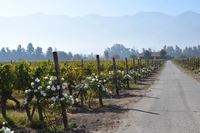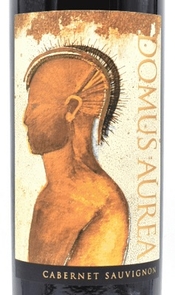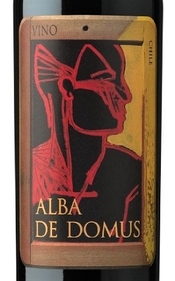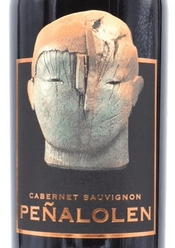My last overseas trip prior to the pandemic shut-down was a wine-intensive vacation to Chile. There were many highlights, and those who’ve never traveled to Chile from the USA should be aware that the flights are easy despite being long, as there’s almost no time change involved and hence virtually no jet lag. Driving in Chile is easy, so renting a car and going your own way at your own pace is likewise far easier than some people might assume. The scenery is varied and extremely interesting, and of course the Andes are spectacular. The fact that seasons are reversed in the Southern Hemisphere opens wonderful possibilities (for example, escape summer heat in DC and go…skiing!). And yet, even among all these highlights, and even though I’m once again traveling frequently, I remain especially attentive to a winery visit with one of my favorite producers worldwide — which began after a 10-minute Uber ride from my hotel in Santiago.
I should note up front that the winery doesn’t offer visits as a matter of course, though members of the wine trade may be able to arrange a tasting. But with that fact acknowledged, you can indeed taste the ultra-distinctive wines from this estate easily enough, and the lineup is so strong from the entry-level offering up to the flagship release that I feel obliged to shine a light on this extraordinary estate.
Its formal name is, “Viña Quebrada de Macul,” but my wine geek friends all refer to it by the name of its top Cabernet Sauvignon, which is “Domus Aurea.” The property has multiple aspects that are remarkable, but chief among them is its location. Some of Chile’s most famous and outstanding reds are made extremely close to Santiago or even within the city limits, such as Almaviva and Concha y Toro’s “Don Melchior” Cabernet. When I first visited these locations years ago, I was astonished at how fully urban they turned out to be. And yet, Domus Aurea is much closer to Santiago’s city center, and indeed the entryway is just across a street from what looks like a vast condominium complex. It is easy to imagine that real estate developers have been gazing at the Domus Aurea vineyard with green-eyed envy for years, and if so, I hereby call down a hex on all of them. “Damn your eyes!” I say, to quote a lyric from Blues Goddess Etta James!
You should take a moment to have a look at the estate’s location. Don’t forget to return to this column afterward, as they highlights are still to come in the form of reviews of three killer Cabs on three price tiers, but simply open a new web browser window and paste in the following address to pull up a map on Google, and then hit a couple of “minus signs” ( - ) to see the location relative to downtown Santiago:
Av. Consistorial 5900, 7940712 Penalolen, Peñalolén, Región Metropolitana, Chile
My admiration for Domus Aurea, Alba de Domus, and Peñalolen (the three wines in hierarchical order, from the top down) stems from one aspect that united them: All three are utterly, unapologetically, and emphatically expressive of their growing site. Driven by three striking notes — eucalyptus, cedar, and salty minerals — they are deeply etched by their precise place of origin. These notes ride atop a core of ripe (but not over-ripe) fruit with both black and red tones as well as accents of cocoa powder and spices, but rarely with sensory signals of new oak poking through, and usually with fine acidity that keep them from seeming soupy or heavy.
These three wines are so distinctive that they are — for me at least — among the world’s most easy to identify when tasting blind. I’m not alone in this, as the following story will convey in spades. My wife — a prominent food journalist but not really a “student” of wine — has loved these wines as much as I do for more than a decade, and accompanied me on my one visit to Domus Aurea in July of 2019. Anyway, about a month ago, I opened the 2018 Alba de Domus at a late-ish point in an evening after finishing my work, by which time my voracious reader of a wife had already tucked into bed with a novel after brushing her teeth. I walked up a glass of the wine to her, without indicating what it was, though she initially shied away from it out of a preference for continuing reading and not needing to brush her teeth gain. Without saying anything about the wine except, “Trust me, it is worth it,” she tasted the wine, reflected for about two seconds, and said: “Domus Aurea or its little brother.” When somebody who isn’t a professional taster nails a wine right down to the vineyard — and manages that through a fresh dose of toothpaste — you know we are talking about a seriously site-specific wine.
Although I’m aware that you might be disappointed by the news that visits aren’t conducted as a matter of course at Domus Aurea, you can take some consolation from the report that this is anything but a Napa-style showplace. It is really just

an urban vineyard within a stone wall with a modest structure that isn’t much more than a slightly gussied-up shed. The obvious emphasis here is on the vineyard and the extraordinary fruit it produces, and the equally obvious objective in the winemaking process is to convey the site in the three wines reviewed below, starting at the top and working down in price. I hasten to add that the steps down in quality are nowhere near as big as the steps down in price; all three wines are excellent values at their respective tiers.
Two last points, on food affinities and how to acquire the wines. All three of them show a combination of moderate weight with intense flavor impact that makes them very versatile with food, as they can stand up to the most robust dishes like roasted lamb shanks or grilled steak, but they won’t overpower less forceful dishes. As for buying the wines, they are in distribution in many states after importation by Global Vineyard Importers, and are also frequently offered on wine.com, which ships direct to consumers in many states. Another very attractive option is to buy direct from the importer at gviwines.com, which offers free shipping on orders of 6 bottles or more. (I just tried this, and it works.) Currently on offer are Domus Aurea 2019 and the 2007 in magnum; Alba de Domus from both 2015 and 2017, and Peñalolen from 2018 and the 2011 in magnum. If you try any of these wines and don’t like them, write to me at
[email protected] and I will drive right over to take them off your hands. I have a fast car, and am not afraid to use it as such when properly motivated. Here they are:
Domus Aurea (Upper Maipo Valley, Chile) Cabernet Sauvignon 2019 ($80, Global Vineyard Importers): This 2019 release is a wonderful

rendition of Domus Aurea, one that shows some noble restraint in terms of the eucalyptus and cedar characters that always mark the wine, and yet not so much restraint that the wine doesn’t remain true to its remarkable growing site, which ultimately powers right through all efforts at restraint. That might seem like a self-contradictory sentence, but it isn’t — as I’d guess experienced admirers of this great wine will agree when they taste this vintage. The wine’s core of fruit is vivid and strikingly pure, showing more black notes than red ones but some of each, with superb depth of flavor and very, very impressive length. However, the exotic “accents” are just as prominent in the wine’s overall impression as that fruit “core,” as the minty, spicy, salty mineral notes are all present in force from the first whiff through the last note in the finish…which is phenomenally persistent. What this wine presents that the Alba de Domus can’t quite match — despite its obvious excellence — is a degree of precision in its proportionality that lets all of its (seemingly countless) aroma and flavor elements work together in an even more impressive harmony, all showing themselves without over-riding any of the others. Chile’s other ultra-premium Cabernets and Bordeaux-style blends are all deserving of the prices they command and the praise they garner, but none of them are as emphatically and proudly Chilean as this one. Don Melchior, VIK, Chadwick, Seña, Almaviva — all fabulous without a doubt, and every one of them more “international” in style (and probably better bets for those who wish to impress important clients when celebrating some deal-signing in a steakhouse without taking a chance on a wine that might raise eyebrows or rub somebody at the table the wrong way). But for sheer distinctiveness and excitement value, none of them can touch this wine.
96 Points
Alba de Domus by Domus Aurea (Maipo Valley, Chile) Cabernet Sauvignon 2018 ($43, Global Vineyard Importers): This is one of the

world’s most deliciously distinctive renditions of Cabernet Sauvignon (which is saying a lot, as Cabernet is planted virtually everywhere in the world where the climate enables vintners to ripen this supremely noble variety). On top of that, it isn’t even the producer’s top wine, but rather a “second wine” of some vineyard plots and barrels selected out of Domus Aurea, the “Grand Vin” from this amazing property, known fully as “Viña Quebrada de Macul.” This wine is the most unbridled and unadulterated expression of classic Upper Maipo Cab that remains in existence, with all the eucalyptus and cedar and salty minerality evident in this bottling, as some of the more “outlandish” plots and barrels are pulled into this, especially in recent years as Domus Aurea is made a little less outlandish to show its greatness alongside more famous wines like Don Melchior from Concha y Toro (that cost much more but are no better on average). The 2018 vintage is fabulous, with really only medium-plus body and weight but overwhelming aromatic and flavor complexity. Every sniff and sip brings forth additional detail, and all of them are eerily proportional and harmonious despite the wine’s extraordinary intricacy. This vintage is just arriving in the country, but once it becomes available, you’ll be able to acquire it directly from GVI Wines if you’re in a direct shipping state. I’ve scored it conservatively because it is such a personal favorite, though I’m aware that not everyone will be equally enthusiastic (which is the natural result when a wine is overloaded with site-specific individuality). Let us all pray that the owners never sell this site to a condo developer; it is virtually surrounded as things stand, and an urban viticultural miracle.
94 Points
Peñalolen (Maipo Valley, Chile) Cabernet Sauvignon 2018 ($20, Global Vineyard Importers): This is the richest, most dramatic rendition of this wine that I can recall, and I can recall lots of them, as I’m

fortunate to taste this wine in almost every vintage. This is basically the “third wine” of a trio if you think about this in relation to the top wines of Bordeaux, with Domus Aurea being the “Grand Vin,” and Alba de Domus being the “Super Second,” to adopt terms by analogy that are familiar to great estates from the Medoc. Working with wines on “tiers” like this offers many advantages to producers and consumers alike. For the producer, it permits assembling the “upper tier” wines by including vineyard plots — and later, barrels of finished wine — that suit the winemaker’s intended style, especially for the top wine. The second wine can still be very, very good but notably less expensive, and the “third wine” can sometimes be a fabulous bargain that offers a taste of a great growing site at an extremely reasonable price. This last description fits the 2018 Peñalolen perfectly. This release is unusually rich and concentrated, which is no doubt partly a function of the growing season, but my educated guess is that the wine also benefits from inclusion of some of the more “minty”-seeming barrels that were not included in Domus Aurea or Alba de Domus. The main vineyard behind these wines has always shown some eucalyptus characters along with other notes associated with Maipo Valley wines close to (or even within) Santiago, and these seem toned down in the 2018 Domus Aurea, but tuned up in this $20 wine. That’s fine with me in both cases, as I don’t dislike these minty notes, though some expert tasters do. Some famous wines such as “Don Melchior” from Concha y Toro and “Insignia” from Joseph Phelps Vineyards in Napa were both re-styled years ago to minimize eucalyptus notes that were once quite prominent in them, and something similar may be going on here, under the ownership of Ricardo and Isabel Peña. My advice is that you should seek this out, try a bottle, and then load up if you like it as much as I do — which is very much. It is dark and deeply flavored and extremely expressive in both aroma and flavor, and also impressive in potential, as it was essentially uncompromised by the trial of being left uncorked and unrefrigerated for a full 24 hours — but then still tasting just as good on a second evening. The bottom line? You’ve surely heard of “grand theft auto,” and at $20, this is Grand Theft Vino, so act accordingly.
92 Points